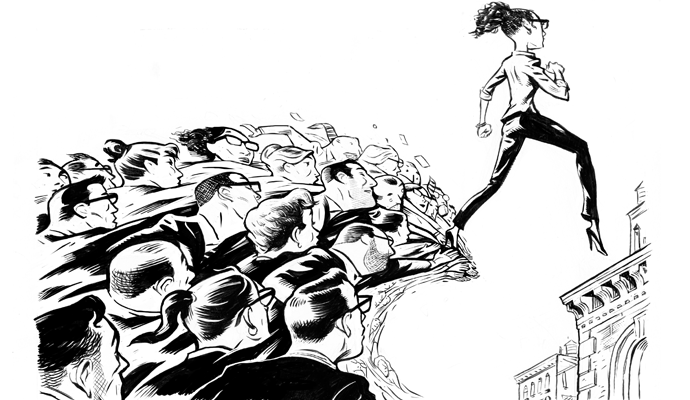11 Types of Strategic Maturity: Which One Describes Your Company?
A quick interactive diagnostic tool shows whether your strategy is coherent, how well it stacks up against your competitors, and how you can improve it.
Almost every business today faces major strategic challenges, but different companies are challenged in different ways. That’s why so much conventional wisdom surrounding strategy — for example, understanding your external environment — can fall short of what a company needs. Winning today requires you to carefully balance your strengths (what you can do incredibly well) against your opportunities (what the market will reward). That complexity requires a level of strategic maturity: the ability to understand what is fundamentally holding you back, and to correct your course accordingly.
A new body of extensive research at Strategy&, PwC’s strategy consulting business, has informed the Strategy Profiler survey, which classifies companies according to the stage they’re at in developing and executing a coherent strategy. The survey takes only three to five minutes to complete, but it can help you see your own company’s strategic maturity more clearly.
We equate maturity with progress on the path to coherence. Companies are coherent when they align their value proposition and distinctive capabilities system with the right marketplace opportunities — and their whole portfolio of products and services. This typically means identifying the few things your company needs to be really good at, and then developing those few complex capabilities until they’re world-class and interlocking. If you can do this, the market rewards you with outsize returns.
These days, most companies recognize the value of this strategic approach, but it isn’t always easy to get from today’s incoherence to tomorrow’s focused strategy. We have identified 11 archetypes, each representing a different level of progress along this path. This analysis incorporated more than 5,000 data points from a previous global study of company decision makers, and from ongoing observations of business strategies. Chances are, your company matches one of these 11 archetypes.
The first three archetypes represent companies that are not concerned about coherence at all. They have not tried to establish focus and consistency in their portfolio of products and services, their capabilities, or value propositions, and they are not visibly moving in that direction:
1. Strategically adrift companies are either failing or lucky. They don’t have a meaningful strategic direction or a clear view of how they create value. The market generally does not perceive them as being advantaged.
2. Undifferentiated companies have products and services that compete effectively, but they lack a focused identity that sets them apart. Because individual products are relatively easy to copy, their advantage generally isn’t sustainable.
3. Underleveraged companies have a relevant strategic direction and good execution; they do many things right. But their strategy lacks coherence — it is based on following multiple directions, even if they fit together poorly. These companies risk losing to more focused competitors.
Two archetypes describe companies that aspire to a coherent strategy but struggle to develop one:
4. Portfolio-constrained companies offer a diverse group of products and services, which makes it very difficult to agree on company-wide priorities (although they’d like to do so).
5. Unfocused companies are pretty good at a lot of things, but not great at anything — and thus, although they value coherence, they struggle to choose which capabilities to prioritize.
Four archetypes refer to companies that have developed a coherent strategy but struggle to execute it:
6. Distracted companies have defined a coherent identity for their company, but they have a hard time resisting diversions. They pursue market opportunities that aren’t in line with their strategy.
7. Resource-constrained companies struggle to find the funds to execute their strategy. Building differentiating capabilities is difficult and expensive, and the executives at these companies don’t think their financial situation allows them to make the bold moves they need.
8. Capability-constrained companies lack the knowledge, skills, or technology needed to build out their capabilities to a world-class level, or to scale them throughout the organization.
9. Overstretched companies have defined a coherent identity for themselves, but it is so far away from the company’s current status — and their ability to enlist customers, employees, and investors on their behalf — that they can’t successfully realize their goals.
The final two categories depict companies that are living a coherent identity:
10. Coherent companies have a powerful value proposition and a system of a few differentiating capabilities that support that value proposition. Their portfolio of products and services grows successfully because of the strengths they consistently bring to bear.
11. Supercompetitors use their coherence to shape their future. They apply their capabilities to a broader range of challenges and loftier goals, serve the fundamental needs and wants of their customers, and ultimately lead their industries. These companies are not just playing the game of business well — they’re changing the rules.
Distracted companies have defined a coherent identity for their company, but they have a hard time resisting diversions.
This diagnostic Strategy Profiler survey developed by Strategy& takes only a few minutes to complete. It will show you which of these 11 archetypes your company is most closely aligned with — and this, in turn, will indicate how coherent your company is, whether it has a clear approach to winning, and whether you stand out from competitors.
The profiler will also show you how your strategy measures up against that of your peers. You will see your company’s coherence score in comparison to the average score in your industry group, and in comparison to those of your top-quartile competitors.
Which stage is your company at? The answer can help you figure out what is holding you back, and decide where to invest your resources and attention to move closer to the coherent, winning strategy you need.
Take the Strategy Profiler survey.




